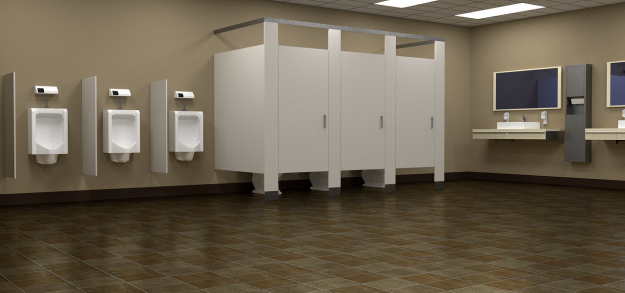Use case: intelligent toilets

What’s the issue?
Adequate access to clean, pleasant to use, toilets may seem rather trivial, however, it’s an important requirement for any university campus. A poor experience can leave a lasting impression of the organisation. Visitors, students and staff will have strong views on the quality of the facilities.
What are the current solutions?
While the design of toilets and toilet blocks has improved over recent years, along with the use of more hygienic materials in their construction, the use of technology and data has been limited. More efficient flushing and more effective hand-dryers are generally the height of current innovation.
Handwritten, cleaner, tick sheets, used to indicate the last time the facility was inspected, are generally the only evidence of data use.
The introduction of the “superloo” provides an automated solution to the hygiene issue but at a cost. These facilities are normally coin operated and situated outside. They are of limited use where high numbers of toilets are required. Their drawbacks include the cost of installation along with high levels of use of water and power.
Are there any current examples?
Movement sensors and foot buttons enabling “no touch” flushing and tap use have been around for a while, but a recent innovation in public toilets sees the introduction of the high tech inspection tick sheet that uses an LED screen to indicate when the operative will return to inspect the facility. This screen can also include:
- Customer feedback buttons
- A call option when an operative in urgently needed
- SMS messaging on the facility status
See the Hygiene Company
Footfall monitoring is clearly important for the management of toilet facilities and is already being used in public building such as airports. The data is used both for planning the development of facilities and, using real-time data, to react to unexpected busy periods. (See: Smart flooring tiles can track your steps)
The key benefits of intelligent toilets include cleanliness, comfort, convenience and conservation. Japanese toilets long been famous for having “smart”, electronic features including automatic flushing, warm seats and water jet washers, even Bluetooth to allow users to listen to the radio. However, these “innovations” have not yet caught on in the west.
Other innovations include apps and sensors that can automatically lift the seat, ultraviolet lights that can break down bacteria and using 35% less water per flush (water that could be provided from rooftop rain storage) See:Smart toilets: how the Internet of Things is changing the washroom experience
The IoT (Internet of Things) has a major role to play in maintaining and improving toilet cleanliness. Internet-enabled toilet roll holders to monitor how much paper is left, bins that know when they are nearly full or soap dispensers that know when they are nearly empty and let the operative know will help with reduced staffing levels. See: The Smart Washroom
The next stage of toilet innovation will also lean heavily upon the use of the IoT. A range of automated sensors, movement, noise and temperature monitoring, possibly including odour sensors, will be used to monitor the facilities. Also, predictive usage levels, using events and timetabling data, to ensure staffing levels are adjusted. Combining real-time data, for example high levels of sales of coffee in the cafe or drinks in a bar, could even be linked to likely high level of toilet use within the next hour. Additionally, the IoT and extensive monitoring combined with the development of self-cleaning technology can lead to a higher quality environment without the need for extra staff.
Slightly more fanciful, but still worth discussion, might be the use of toilets to monitor user health. The idea of domestic toilets being part of the IoT and sampling a person’s waste to report on their health (pregnancy test, PSA levels, infections, alcohol use, blood sugar and cholesterol levels) is being proposed. This could also be done in campus toilets, anonymously, with data being collected to monitor and evaluate the health of a campus population and identify trends. See the Wired article: The Toilet and Its Role In the Internet of Things.
Additionally, the Intelligent Campus is always looking for opportunities to use Nudge Theory to influence user behaviour. Toilet use is an obvious candidate. The fly image in the urinal bowl is a famous Dutch example encouraging men to use this “target” to avoid splashback and help with cleanliness, this has even been developed into a football based game. (See: Toilet Nudging). Similarly, signs and graphics to encourage putting down the toilet seat or lid can be effective. The image of some eyes above a soap dispenser and a citrus smell have been shown to improve hand washing. (See: Two Weird Nudge Improve Handwashing)
What about ethical and other issues?
There will, of course, be privacy concerns with Intelligent Campus’ use of monitoring and data associated with toilet use, particularly where user health might be monitored. This was illustrated by a Finnish company (Futurice) that used a mapping App to show which toilets are vacant in real time (red = occupied, green = free). This was felt intrusive by some staff and the company decided to allow staff to opt in, or out, of the scheme at any time (See: The internet of things in changing the washroom).
Who needs to be involved?
The campus estates department will be key when planning a move to intelligent toilet facilities. Cleaners and cleaning management, along with building management will need to be involved. However, catering, timetable, event and data management units will also have a role to play in creating a high-quality facility and service.

